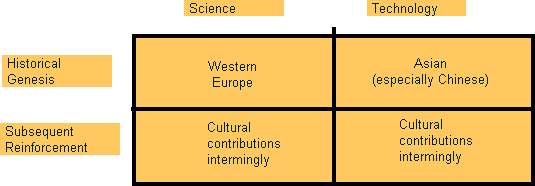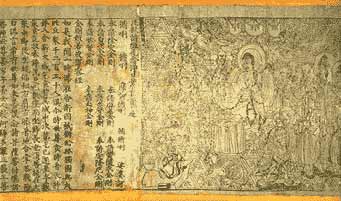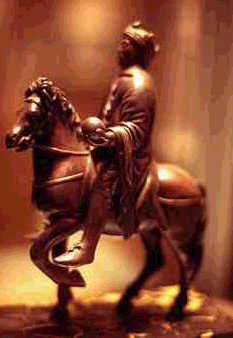Part 1 -- The History of China
Before we discuss individual technological developments, you should read the following three essays that will give you a historic context for these developments.
Concise Political History of China, an online article by Paul Halsall compiled from Compton's Living Encyclopedia on America Online, http://acc6.its.brooklyn.cuny.edu/~phalsall/texts/chinhist.html
Chinese Periodization in Light of Economic Developments by Paul Halsall, http://acc6.its.brooklyn.cuny.edu/~phalsall/texts/chron.html
China, Technology and Change, an article by Lynda Shaffer, from the World History Bulletin, Fall/Winter, 1986/87, http://acc6.its.brooklyn.cuny.edu/~phalsall/texts/shaffer.html
China's Gifts to the West by Professor Derk Bodde, for the Committee on Asiatic Studies in American Education
-
-
-
- Reprinted with permission in China: A Teaching Workbook, Asia for Educators, Columbia University, http://afe.easia.columbia.edu/song/readings/inventions_gifts.htm
-
-
Part 2 - Science and Technology in China
Science in China has a long history and developed quite independently of Western science.Needham (1993) has researched widely on the development of science and technologies in China, the effect of culture, and the transference of these principles, unacknowledged, to the West.The Chinese contribution to Western science is particularly interesting because it serves as a center of controversy about the roots of Western science.
According to traditional Western scientists, the roots of science and the scientific method is in Greece and Greek thought.There is a tendency among scientists to claim that not only modern science, but science in general, was characteristic of European thought.The accompanying argument in that all scientific contributions from non-European civilizations were technology-based, not science-based (Needham, 1993).
"Albert Einstein one remarked that there is no difficulty in understanding why Indian or China did not create science. The problem is rather why Europe did, for science is a most arduous and unlikely undertaking. The answer lies in Greece. Ultimately, science derives from the legacy of Greek philosophy. The Egyptians, it is true, developed surveying instruments and conducted certain surgical operations with notable finesse.The Babylonians disposed of numerical devices of great ingenuity for predicting the patterns if the planets. But no Oriental civilization graduated beyond technique or thaumaturgy to curiosity about things in general. Of all the triumphs of the speculative genius of Greece, the most unexpected, the most truly novel, was precisely its rational conception of the cosmos as an orderly whole working by laws discoverable in thought..." (Gillispie, 1960)
Needham (1993), instead, looks at the distinction and definitions about science as too narrow.Mechanics was the pioneer among the modern sciences and the precursor to the mechanistic paradigm that all other sciences endeavor to imitate.Needham also concedes that mechanics is based on Greek deductive geometry.
|
Artist Name: Bing Li To view a larger version of this picture, |
However, Needham (1993, p. 43) points out that modern science is much more than mechanics and has greatly expanded beyond the boundaries of mechanistic thinking.He looks at the development of science as a mixture of influences from different cultures and peoples.
"Suppose we erect a classification of four pigeonholes, science vertically on the left and technology vertically on the right, and let the upper boxes represent direct historical genesis while the lower ones represent subsequent reinforcement. Then taking the upper left-hand compartment first, the contribution of the Greeks will have the greatest share, for Euclidean deductive geometry and Ptolemaic astronomy, with all they imply, were undoubtedly the largest factor in the birth of the 'new, or experimental. science'....In the upper right hand compartment the situation is entirely different, for in technology Asian influences in and before the Renaissance (especially Chinese) ere legion..."

Needham sees the bottom two compartments are being able to take achievements from non-Western cultures.In the case of scientific development, Needham notes many Asian accomplishments which preceded Western developments; however, many times without directly building on them.
In technologically development, the story is much different (see Burke (1978) for more descriptions of these innovations). There have been many Western innovations that have their basis in China, particularly those in printing (paper, block printing, and moveable-type printing), agricultural technology (irrigation systems), mechanical engineering (clockwork, iron, and lead manufacturing, efficient harnesses), and martial (gunpowder, the precursors to the barrel gun, and cannons) technology.
We will discuss the contributions of China to the history of technology by focusing on a few key innovations.
Paper and Printing Technology
We don't know exactly when paper was first used in China but evidence from archaeological records indicate that it was prior to the first century AD. In China, the most common source for paper was the bark of the paper mulberry tree (Gies & Gies 1994 p 182). Paper is made by tearing up rags, or the bark of trees or certain grasses and putting them into a large pot with water. The mixture is boiled and the pulplike mass that lies at the bottom is removed, strained and spread out to dry. Originally, paper was rough but, eventually over time, the making of paper was improved with sizing, dyes, and the use of molds made out of bamboo strips. Paper was first used by the Chinese for wrapping and it was not until the 3rd century that paper replaced bamboo, silk, and wood as a writing medium.
|
According to Gies & Gies (1994), paper is one of the Chinese technologies that we can trace in its transfer to Western Europe. And, this transfer had two stages with the actual paper products transferred in the first stage and the paper manufacturing technology in the second stage. The first countries to acquire paper were Japan, Korea, and India when they began trading with the Chinese. Paper moved to Western Europe via the Old Silk Road (click on this link to learn more about the Silk Road, http://www.regit.com/regitour/china/intplace/silkroad.htm). The Arabs captured Chinese paper craftsman in 751 and brought them to Samarkand. Soon after, a Muslim paper mill was established at Baghdad and paper was used throughout the Muslim world by 1000 AD. As with many Muslim technologies, paper found its way to Europe through Muslim Spain (and Muslim Sicily) where paper industries were established in the 10th century. |
|
But writing was not the only use for paper. The Chinese began using paper, made from rice straw, for toilet purposes in the sixth century, AD. Also, the Chinese began to have a paper currency in the early 9th century. For more details about the development of paper, visit this web site, Paper, http://scholar.chem.nyu.edu/tekpages/paper.html
|
The earliest printed book, AD 868. To view a larger photo of this book and to read more about it, you can go to this web page, http://portico.bl.uk/diglib/treasures/diamond-sutra.html |
|
A second technology developed in China was printing. The Chinese began to use wood block printing in the 7th century where the text is carved into the wood blocks which are then inked. A blank sheet of paper is placed over the inked block so that the image can be transferred to the paper.
"T'ang culture. Buddhist influence in art, especially in sculpture, was strong during the T'ang period. Fine examples of Buddhist sculpture are preserved in rock temples, such as those at Yongang and Longmen in northwest China. The invention of printing and improvements in papermaking led to the printing of a whole set of Buddhist sutras (discourses of the Buddha) by 868. By the beginning of the 11th century all of the Confucian classics and the Taoist canon had been printed" http://acc6.its.brooklyn.cuny.edu/~phalsall/texts/chinhist.html
Moveable type was also invented by the Chinese in the 11th century. A Chinese artisan named Pi Sheng created characters out of clay which he fixed to an iron plate with pine resin, wax, and ashes. After the plate cooled, he inked it and printed. But, since the characters were only attached with wax and resin, one could heat the iron plate to remove the characters--therefore, this was removable type. Metal movable type was first created in Korea in the 15th century. After this, printing found its way to Europe (although we don't exactly know how).
To read more about printing, please read the following web sites
The history of paper, http://www.silk-road.com/artl/papermaking.shtml
Printing in China's Gifts to the West by Professor Derk Bodde, for the Committee on Asiatic Studies in American Education, Reprinted with permission in China: A Teaching Workbook, Asia for Educators, Columbia University, http://afe.easia.columbia.edu/song/readings/inventions_gifts.htm#printing
Matteo Ricci: The Art of Printing (late 16th Century CE). In this original source, the Western priest, Matteo Ricci, describes the process of block printing in China, http://acc6.its.brooklyn.cuny.edu/~phalsall/texts/ric-prt.html
Gunpowder
There is not doubt that the Chinese invented gunpowder. The ways in which they used it and how their use of gunpowder differed from the West has been debated. The first known recipe for saltpetre, the principal ingredient of gunpowder, can be found in a Chinese military manual written by Wu Ching Tsung Yao from 1044 (Burke, 1978). This military manual also gave directions for making a bomb using gunpowder so most historians believe that bombs or grenades were used by Chinese troops from before the 11th century. And, although the Chinese did use gunpowder in fireworks for religious purposes, they also used gunpowder in cannons, rockets, and guns. Rocket arrows were used in 1126 to defend the city of Kaifeng which was the capital of the Sung empire.
Gunpowder and rockets were transferred to Europe in the 13th century although we are not sure by what means the recipe for gunpowder found its way to Europe. The first mention of gunpowder in Europe was in a 1268 essay by Roger Bacon, the famous English scientist and philosopher.
|
"We have an example of these things...in that children's toy which is made in many parts of the world: i.e., a device no bigger than one's thumb. From the violence of that salt called saltpeter together with sulfur and willow charcoal, combined into a powder, so horrible a sound is made by the bursting of a thing so small, no more than a bit or parchment containing it, that we find the ear assaulted by a noise exceeding the roar of strong thunder, and a flash brighter than the most brilliant lightning" (Roger Bacon, quoted in Gies & Gies, 1994, p. 206). |
|
Even though we are not certain how the recipe for gunpowder arrived in England; by the mid-14th century, this knowledge appeared to be widespread. In 1331, cannons were by German knights used to capture a town in Italy, Cividale and Edward III brought at least twenty guns and gunpowder with him in his siege of Calais in 1346. In any case, by 1418, the city of Ghent was ordering 7200 cast iron cannonballs. In an age of warfare, this new technology was exploited to the fullest by Europeans.
|
|
The art (and technology) of war changed during the Medieval Age. At the beginning, most of the troops fought on foot with weapons carried in their hands. By the end of this period, both artillery and the cavalry were playing a large role in battle. There were many changes in war technologies during the 1000 years that comprised the Middle Ages; here we will focus on a few critical technologies and how they changed the practice of war. During the end of the Medieval Age, war was significantly altered by the development of Gunpowder weapons of two types: artillery, and hand-held guns. It is clear from history that gunpowder developed in China but its use in China dropped after the 13th century (Ross, 1982). To conclude our discussion of gunpowder and weapons, you should view these sites. A BRIEF HISTORY OF ROCKETRY, http://www-pao.ksc.nasa.gov/history/rocket-history.htm Non-gunpowder artillery. This site describes the range of tension and torsion powered machines used in this time period. http://www.xenophongroup.com/montjoie/ngp_arty.htm Gunpowder Weapons of the 15th Century. http://www.xenophongroup.com/montjoie/gp_wpns.htm
|
The Compass
The ability to magnetize iron by placing it near a loadstone was known to ancient civilizations. But, it was the Chinese who applied this principle of magnetism to create the compass. The oldest picture of a magnetic compass, from 200 BC, was using a small spoon as the needle that was thrown down upon a table that was engraved with the compass points. These early compasses were used in divination rather than in navigation--"the board was used by geomancers to detect the 'winds and waters of the earth" (Gies & Gies, 1994, p. 94). In the Han dynasty (202 BC-AD 220), the "south-pointer" was used by travelers in China (the earliest Chinese compasses, called south-pointers, pointed south rather than north).
|
|
Title: Solar quadrant & compass |
The next significant development was the use of a magnetized needle that was floated in a bowl of water on a piece of wood or suspended by a silk thread--these compasses were used by the 8th century in China. And, Chinese sailors used the compass for navigation by the 11th century. At this time (12th through 15th centuries), China developed the largest navy and was the greatest sea power in the world. As just one example of the size of this navy, Kublai Khan attempted an invasion of Japan in 1281 with a fleet of 4400 ships (McClellan & Dorn, 1999). It is obvious that any technology that assisted in navigation would be greatly appreciated. As with other innovations, the compass was transferred to Europe by the end of the 12th century. Whether it was transferred by means of the Silk Road or through Muslim sea traders is in debate.
To finish the discussion of magnetism and the compass, please read these two pages
Magnets, http://scholar.chem.nyu.edu/tekpages/magnets.html
The Compass, http://scholar.chem.nyu.edu/tekpages/compass.html
Conclusion
This completes our section on Chinese contributions to technology. The Chinese contributed other technologies to the Western world including:
the wheelbarrow, http://scholar.chem.nyu.edu/tekpages/wheelbarrow.html
the grindstone, http://scholar.chem.nyu.edu/tekpages/grindstone.html
the horizontal loom, http://scholar.chem.nyu.edu/tekpages/loom.html
But, overall, these developments should show you the interrelationship between a technology and its culture. As we can see by the development of the compass, it is hard to separate the need from the technology. Did the need for better navigation because of increasing sailing lead to the development of a better compass) with a magnetized needle? Or did the development of the compass lead to the growth of China's sailing fleet. Which one was the cause and which was the effect? We will never know but at least we can see that technology and society are interwoven throughout history.
This is the last section in our unit on the history of technology. From here, you can either return to one of the previous sections or continue on to the class activity.
Islam Spain and the History of Technology
References
Burke, J. (1978). Connections. Boston: Little, Brown & Company.
Burke, J. (1978) Connections. Boston: Little, Brown.
Gies, F., & Gies, J. (1994). Cathedral, forge, and waterwheel. New York: HarperCollins.
Gillispie, C.C. (1960). The edge of objectivity: An essay on the history if scientific ideas. Princeton, NJ:
McClellan, J. E., & Dorn, H. (1999). Science and technology in World History. Baltimore, MD: Johns Hopkins University Press.
Needham, J. (1993). Poverties and triumphs of the Chinese scientific tradition. In S. Harding (Ed.), The "racial economy" of science (pp. 30-46).Bloomington: Indiana University Press.
Other Web Resources
Internet East Asian History Sourcebook. This portion of the Medieval Sourcebook focuses on the contributions of East Asia (China, Korea, Vietnam, Japan, and India) on history. http://www.fordham.edu/halsall/eastasia/eastasiasbook.html





